|
|
Brief
information on
|
|
Nikon / Nippon Kogaku Japan special
application Micro-NIKKOR 1:5 f=7cm (70mm f/5) , Micro-NIKKOR
1:5.6 f=150mm (150mm f/5.6) & Macro-NIKKOR
Series of lenses
|
Introduction
Today, Nikon probably is more well known as a camera and lens manufacturer. But the
Company was started in 1917 after merger of 3 local optical manufacturers to form
an alliance known as known as Nippon Kogaku K.K. before change of name to Nikon.
They produced general optical instruments such as binoculars, microscopes, eyeglasses
(some products such as binoculars were marketed under the name of MIKRON and this
was replaced very late with "Nikon" in 1959). On the other hand, the microscope
made by the Company used "JOICO" in 1925 and changed to "NIKKO"
in 1935. The Company may has also produced special requested optical instruments
such as aerial surveillance equipment for military use But it was only in 1932, the
trade name of "Nikkor" was adopted for the first time as
the brand name for their camera lenses; while "Nikon" for
camera was used only in 1946 (with the first camera, Nikon I , introduced in 1948).
During the period '30~'40, they had also began production of lenses for large format
cameras as well as smaller lenses even for other camera makers, which includes Seiko
Kogaku/Hansa, or more popular known as
Canon today. The post war period of Nikon began shifted their attention to other
areas, which includes cameras, microscopes, binoculars, surveying instruments, measuring
instruments and ophthalmic lenses etc. The initial success of the rangefinder Nikon
and overwhelmed popularity enjoyed with the early Nikon reflex cameras had the Company
clearly established as a respectable camera manufacturer as well as extending benefit
in acknowledging quality of optical instruments Nikon produced.
There are series of Nikkor lenses being produced which may had confused a of of Nikon
users. Although I am not too good in the respective fields where their actual applications
were actually meant for (the scope may cover from medical, scientific, industrial,
IT manufacturing, biological studies, dark room, laboratory, post printing and even
for cine and TV broadcasting etc.), but I simply intend to list some of them in orderly
manner so as for all of us to share and/for for quick reference guide. I am equally
aware there are many enthusiastic collectors of these Nikkor, so if you have other
versions or possess in-depth knowledge relates to corresponding application for each
type of these specialized optical series, you may contact my buddy,Rick <rick-oleson@yahoo.com>
where we can create another site extension from here. Thank you.
To begin with, other than the popularly known Nikon 35mm S-Mount rangefinder Micro-Nikkor.C 1:3.5 f=5cm model discussed earlier, the Nikon Micro-Nikkor lens family
actually has another two models, namely Nippon Kogaku Japan Micro-NIKKOR 1:5 f=7cm
and Nippon Kogaku Japan Micro-NIKKOR 1:5.6 f=150mm. It was not exactly known both
the 7mm and 150mm were made for as most often, even when the reflex- version of Micro-NIKKOR
55mm/3.5 & 105mm f/4 were in the market, many official Nikon published sales
leaflet and/or Sales Manual listed the 7cm/150mm Micro-NIKKOR by by side. Few of
the main differences which separate the two types were:1) The lens-mount,
with the S-Mount for rangefinder, F-mount to fit the 55/105, but the 7cm/150 has
neither of these; 2) Focusing range: the normal S/F-mount can be focus from
nearest distance to infinity. But the 7cm/150mm were made for close focus and require
bridging between camera and lens. 3) Magnification aspect. Standard magnification
between the series are more of lens the same; for an instance, 1/10X for 55/3.5,
1/10X for 150/5.6 and 1/12X for 7cm. But the usable Magnification can be varied greatly
and this is where the Micro-NIKKOR 1:5 f=7cm / Micro-NIKKOR 1:5.6 f=150mm truly excel
from the normal Micro-NIKKOR 55/3.5 or a 105/4. For an example, usable magnification
with 55/3.5 provides 1/OOX~ maximum 1X with use of accessory or extension; but an astonishing
high magnification of 1/30X ~1/5X is delivered with BOTH the Micro-NIKKOR 1:5 f=7cm
and Micro-NIKKOR 1:5.6 f=150mm ! In a Nikon Sales Manual, it explained Micro-NIKKORS.
" .. for the field of micrographic, Micro-Nikkor lenses offer high resolution,
flat ness of field and freedom from astigmatism - essential quality that are prerequisites
for producing high quality microcopies or microphotographs. The special characteristics
of Micro-NIKKOR series are corrected for aberrations at their standard reduction
ratios, as opposed to conventional lenses which are corrected at infinity focus.
Further, the diameters of front/rear element groups are larger than dimensional aperture
of the lens so that minimal vignetting occurs with the lens only by moderately stopped
down. However, due to their extreme flatness of field, it is vital to keep planes
of object and film precisely parallel ...".
Here is a link to a Japanese Collector, Michio Akiyama, where his site has pointed
to his friend's Uli Koch from Germany web page showing a 4 models of early Micro-Nikkor appeared together in a leaflet published by Nikon during the
'60. By the way, Mr. M. Akiyama probably has the most detailed information on series
of specialized Nikkor lenses on the web, for those who may be interested to beef
up personal knowledge should take a good read at them <website in both
English and Japanese>.
Nippon Kogaku Japan Micro-NIKKOR
1:5 f=7cm (70mm f/5). (1st draft 06/06/2011)
Year introduced: 1958* ; discontinued: No exact info. * Ref: Nikon Hand Book
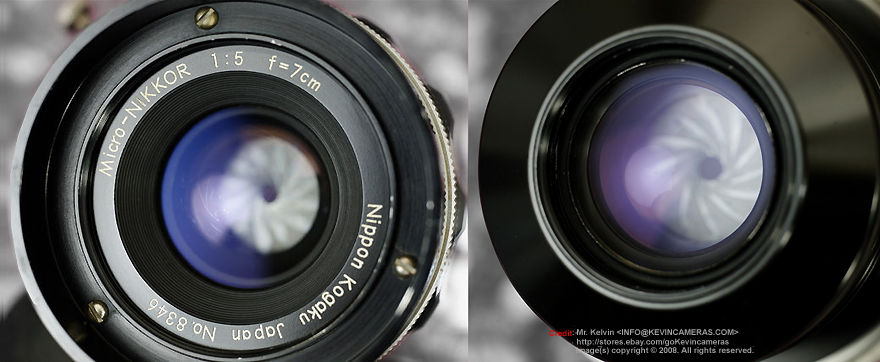
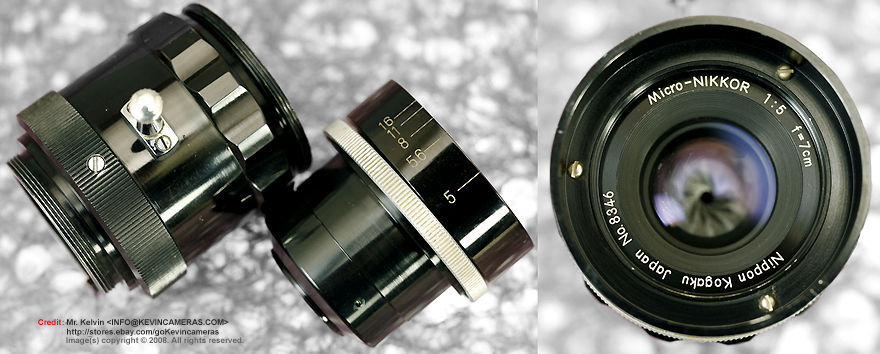
I
don't have much information on the lens, but as 7cm (70mm) optic is equally odd for
a traditional 35mm Nikkor where it is a 40% extension in focal length as to S-mount
Micro-NIKKOR 1:3.5 f=5cm (50mm). It used a similar 5E/4G basic optical design but
actual dimension is different due to longer focal length of additional 20mm. It measures
approx. 32mmx 45mm but weighs heavier at 180g as compared to 5cm/3.5's 144g. The
MN 7cm/f5 consists of two parts with one section of lens tube has a release switch
while the lens component section can be detached away from the external barrel. Apertures
are marked at the front ring from f/5, f/5.6, f/8, f/11 and f/16 but there is no
aperture ring nor encoded with depth of field scales. The focusing ring - not exactly
a ring as the grip is a smooth surface, fixed type with no texture at all. But this
was changed/improved at the later version (see below for version
uses 70mm model)
Basic technical specification
of Micro-NIKKOR 1:5 f=7cm / 70mm f/5
(extracted from Nikon Sales Manual)
Focal length: 70mm
Maximum aperture ratio: 1:5
Minimum Aperture: f/22
Optical Design (elements/groups): 5 elements in 4 groups
Standard Magnification: 1/12X
Usable Magnification range: 1/30X ~1/5X
Picture Angle:- 43°
Corrected chromatic aberration range: 400nm~650nm
Vignetting: 0% (f/7); Distortion: 0.3%
Image size: 55.2mm dia.; Original size: 662.4mm dia.
Image distance at standard magnification @1/12X:- 985.8mm
Resolution: - Weight: 250g
Compare the Micro-NIKKOR 70mm f/5, Micro-NIKKOR
150mm f/5.6 lens construction diaphragm
(52k gif) with the F-mount Micro-NIKKOR 55mm f/3.5 --- >>> |
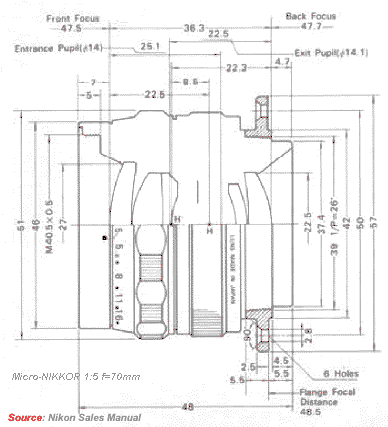
|
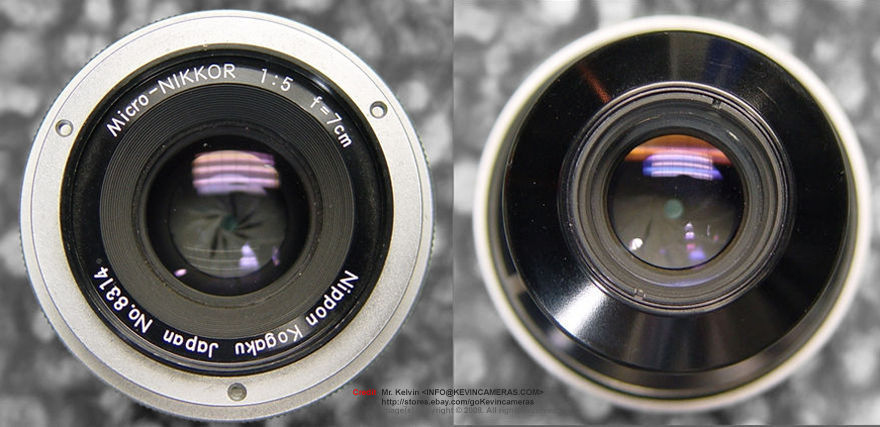
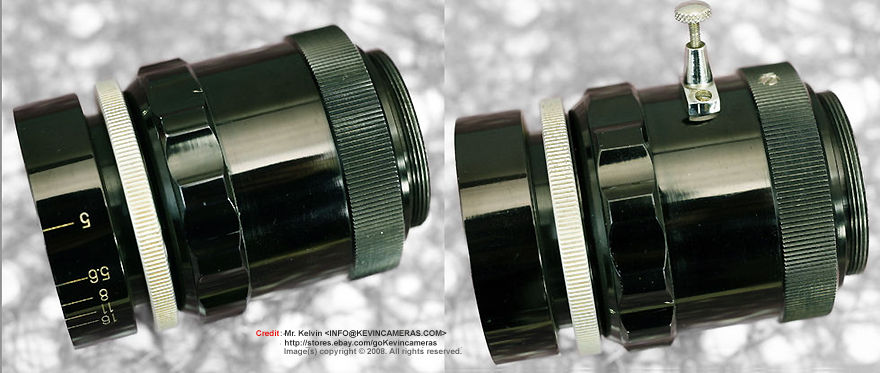
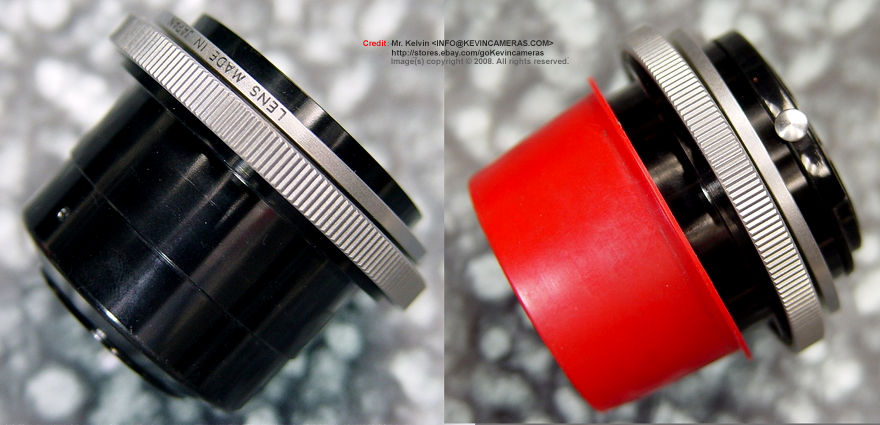
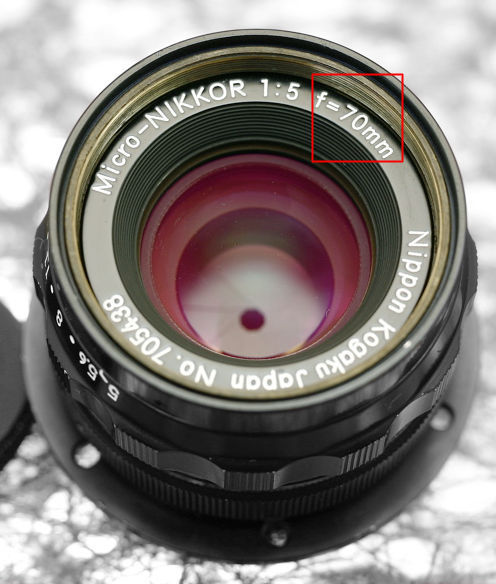 |
<<< --- This
Nikon Micro-NIKKOR 1:5 f=70mm uses new focal length scale of 70mm
instead of 7cm. But the most significant change as compare to earlier model
is the one-piece design used. Next, the release switch on lens barrel has been eliminated
and the front section has a '60 F-mount Nikkor preset-type of early design where
it can be turned to control the aperture, the scales were marked from f/5, f/5.6,
f/8, f/11, f/16 and f/22.
The S/N with a rather high sequence in 6 digits numbering and this may suggest this
model could be introduced at a much later date. Further, focusing collar on this
version uses a typical reflex F-mount period kind of design, textured and may provide
a firmer grip for whoever that is using it. No info is available for its optical
composition but could be the same with the older model.
Anyone has further info ?
Suggestive Link(s):-
Enrico Savazzi site has an excellent article on
the lens as well as some explanation of lines resolution with Micro-Nikkor 70mm f/5.
Note: A micrometre is one-millionth of a metre (1/1000 of a millimetre,
or 0.001mm). Its unit symbol in the International System of Units (SI) is µm.
The nanometre was formerly called also millimicron,since it is 1/1000 of a micron,
and was often denoted by the symbol mµ or (more rarely) µµ. or
A unit of length equal to one thousandth (10-3) of a micrometer or one billionth
(10-9) of a meter. (Mathematics & Measurements / Units) an obsolete name for
a nanometre; one millionth of a millimetre. Useful links: What Wavelength Goes With a Color?
|

Nippon Kogaku Japan Micro-NIKKOR
1:5.6 f=150mm (150mm f/5.6).
Year introduced: 1960* ; Discontinued: No exact info; * Ref: Nikon Hand Book
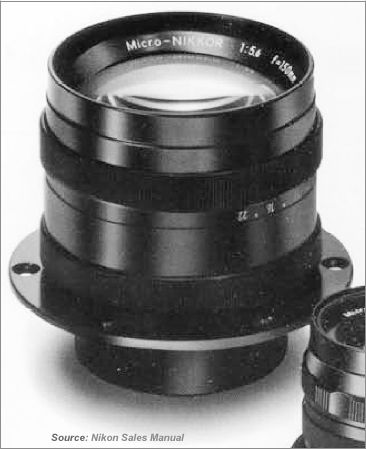 |
At 150mm focal length, what I can recall
Nikon had only produced three lenses in the enlarger EL-series, namely EL-NIKKOR
1:4N f=150mm, EL-NIKKOR 1:5.6 f=150mm and EL-NIKKOR 1:5.6A f=150mm; and four additional
Nikkor-W/SW lenses for 4 x 5 large format usage (Nippon Kogaku Japan NIKKOR-W 1:4.5
f=15cm, NIKKOR-SW 1:4 f=150mm, NIKKOR-W 1:5.6 f=150mm and NIKKOR-W 1:8 f=150mm).
Today, in the eyes of collector, Micro-Nikkor 150/5.6 is very rare piece of optic.
According to literature, this lens came after the 7cm and possibly only having "mm"
version and no "cm" marked for its focal length description). According
to one leaflet distributed by Nikon, it explained the development of the lens was
cater for increase of demand for high resolution lens for films with a width of 70mm
in microfilming sector where larger size originals such as blueprints and weather
charts that have small characters or letters. So, this lens basically was meant for
microfilming which may require high resolution image capture over a large picture
area. It also meets requirements in the filed of photoengraving as well as in specific
field use for electronic industries. The Micro-NIKKOR 1:5.6 f=150mm used a different
new optical construction of 6 elements in 4 groups design which Nikon claimed to
provide the highest resolution lines (150 lines/mm@f8) among the few F-mount Micro-NIKKORs
and the Micro-NIKKOR 70mm f/5; while the range of reproduction ratio works from 1/5X~1/30Xcovering
an image area of 64mm x 95.5mm. It doesn't seemed to provide infinity focus as suggestive
overall working range is 1,815mm. It has a screw mount (d=72mm p-1mm) & Adapter
plate at the outer ring like the APO-NIKKOR series of enlarging lenses (o.d.=98mm).
It measures 80mm (D) x 86mm (L), weighs 600g/1.32Ibs). For an actual view of a Micro-NIKKOR
150/5.6, go to Uli Koch, Germany web page.
|
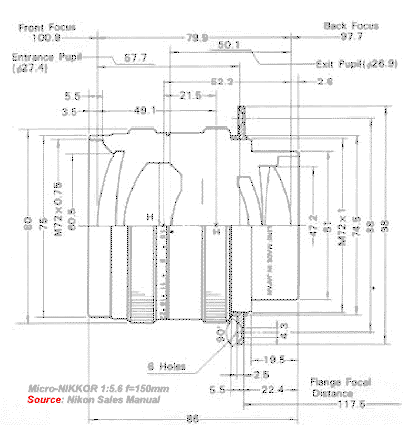 |
Basic technical specification
of Micro-NIKKOR 1:5.6 f=150mm
(extracted from Nikon Sales Manual)
Focal length: 150mm
Maximum aperture ratio: 1:5.6
Minimum Aperture: f/22
Optical Design (elements/groups): 6 elements in 4 groups
Standard Magnification: 1/10X
Usable Magnification range: 1/30X ~1/5X
Picture Angle:- 41°
Corrected chromatic aberration range: 400nm~650nm
Vignetting: 0% (f/8); Distortion: 0.1%
Resolution: 150lines @f/8 at 546nm,e-line (1/10X)
Image size: 115mm dia.; Original size: 1,150mm dia.
Image distance at standard magnification @1/10X:- 1,815mm
Dimension: 80mm (D) x 86mm (L); Weight: 600g/1.32Ib
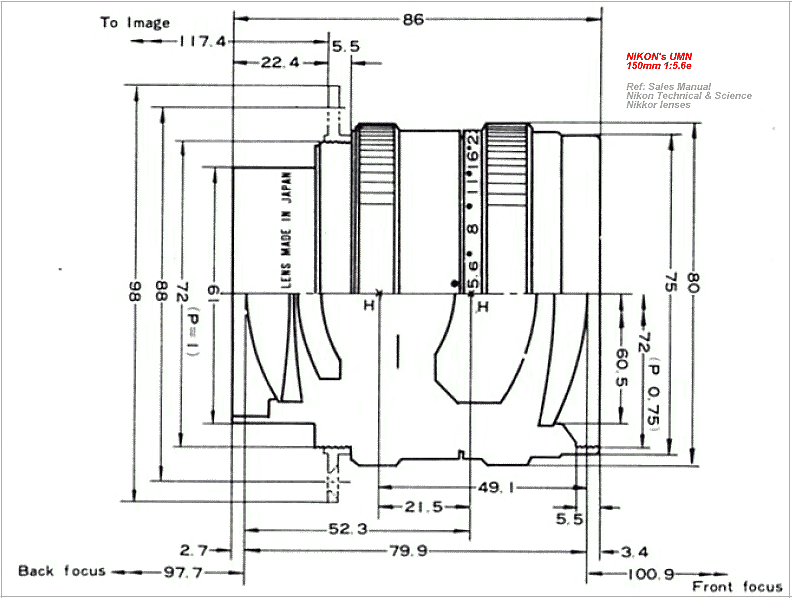 |
<<<--- Compare the Micro-NIKKOR 70mm f/5, Micro-NIKKOR
150mm f/5.6 lens construction diaphragm (52k gif) with the F-mount Micro-NIKKOR 55mm f/3.5
|
|
|
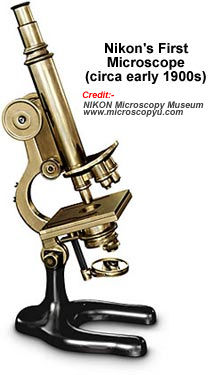 |
Nippon Kogaku Japan Macro-NIKKOR lenses. Year
introduced/discontinued: No exact info, probably during early '60
The Nippon Kogaku Macro-Nikkor lens series consist of Macro-Nikkor 1:2.8
f=19mm (white-lined R-Ratio 15X~40X), Macro-Nikkor 1:4.5 f=35mm (blue-lined R-Ratio
8X~20X), Macro-Nikkor 1:4.5 f=65mm (Yellow-lined R-Ratio 3.5X~10X), Macro-Nikkor 1:6.3 f=120mm (Red-lined
R-Ratio 1.2X~4X)
Between '60 ~'70, Nikon already
had already established a very mature facilities to supply specialized microscopes
for scientific, laboratory, medical studies and other industrial needs. Probably
in the field of microscope application, it may never be that easy prior to arrival
of reflex-SLR, as convenience of TTL direct viewing provided by a SLR camera provides
image viewing and capture process on microscopes can be readily recorded. During
the rangefinder era, Nikon did produced a Microflex Kit which enabled
a number of their Nikon S-series RF cameras to be used for micrography, as the Nikon
Microflex will be covered in another section in this site, but it has many models
such as PFM, EFM, AFM, CFM and the concept was extended to the reflex-mount F period.
Anyway, Nikon was not the only manufacturer in this field, as microscopes during
the corresponding period were mostly using a universal Royal Microscopical
Society (RMS) thread. This standard was shared among some of the most
respected manufacturers in the microscope business such as Zeiss, Leica, Olympus
and Nikon. Although each maker may offer a wide range of objective designs to meet
the performance needs of specialized imaging methods but during the period, but the
RMS thread was a standard. For microscopes, Nikon had produced a series of lenses
called Macro-NIKKOR. which consists of 19/2,8, 35/4,5, 65/4,5, 120/6
where sometimes we referred them as Microscope Nikkors.
Each of these Macro-NIKKOR had been individually optimized for a restricted range
of magnifications and marked on lens with its R-ratio working range. The series enable
adequately for coverage needs of variable magnification from 1:1~ 40:1 ! Although
the Macro-NIKKOR were made as microscope-specific but it can also be mounted on a
Nikon reflex camera via bellow/adapter such as BR-15, BR-16 or other combinations.
Naturally, they also made adapters to enable other microscope labels to use the Nikkor
or the other way round, such as L-F Adapter, enables it to mount any of the RMS lenses
on M39 Leica thread mount. This means adapters permits interchangeability among many
labels. However, as I am not good at this specific field and don't intend to go further
other than by just a rough overview.
|
| NOTE: - For those who may be interested, here are two LINKS, one is to
NIKON's Microscope division website and another is a useful article written original by Giorgio Carboni,
with translated doc edited by Harry C. Brown "How to with a Microscope". The adapter principle is applicable even today,
meaning you can actually mount a Nikon made microscope lens head via adapter to a
Nikon AF camera and even used for other camera labels. By the way for photographers
who has keen interest into the fascinating world of macro-photography, Nikon has
an annual photo contest called "SMALL WORLD" do show your talent or work there okay ? |
Macro-NIKKOR 1:2.8 f=19mm (white-lined R-Ratio 15X~40X)
This 19/2.8 Macro-NIKKOR provides
the highest magnification ratio among the 4 models shown here. Although it has almost
the same small dimension with the shorter focal length series but the maximum aperture
has a very bright f/2.8. I am not sure if any of the older NIKON microscopes would
provide any form of automatic diaphragm but quite certain they don't as the lens
part doesn't has any mechanism caters for such possible function. When it is use
with a Bellow unit, it has to be mechanically coupled and setting aperture should
be manually. So a brighter f/2.8 lens may provide elevated degree of convenience
for a more comfortable viewing during operation and/or examination of details.
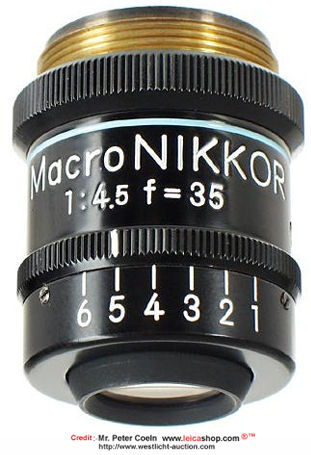 |
Macro-NIKKOR 1:4.5 f=35mm (blue-lined R-Ratio 8X~20X)
This 35/4.5 Macro-NIKKOR shares a very
compact design and providing magnification from 8X~20X.
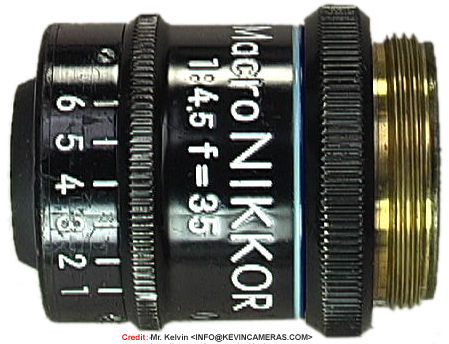
|
Macro-NIKKOR 1:4.5 f=65mm
(Yellow-lined
R-Ratio 3.5X~10X) I don't have any images to show this model here but there are two sources
where you can take a look how it is like. Peter Braczko's Nikon Hand Book page 10-3,
has a photo of the lens shown in black / white but interesting note is, the lens
has better and clearer print of lens data at the front ring. The focusing ring on
the shown unit used a mix of a grooved scallop-type design with a more modern Nikkor
diamond grip pattern like those Nikkor of late '60. Partly, this provide a clue that
the Macro-NIKKOR 65mm f/4.5 could be introduced at a much later stage than the others
M-Nikkors. The dimension of the lens is not pin-sized anymore, measures almost like
the Macro-Nikkor 120mm f/6.3. If you don't intend to buy Peter's excellent book and
prefer just to have a quick glimpse to satisfy your curiosity, Japanese collector
of these Macro-Nikkor, Michio Akiyama has a picture of the lens mounted on his reflex Nikon F2 Titan.
Nikon Macro-NIKKOR
1:6.3 f=120mm (Red-lined R-Ratio 1.2X~4X)
Goohs..at first look this lens could easily mislead
you to relate it to a modern red-lined Canon L-series optic, huh ? Wondering whether
design of a '60~'70 Nikkor lens had actually "inspired" others, hehe ..regardless,
this is a very beautifully crafted Nikkor lens.
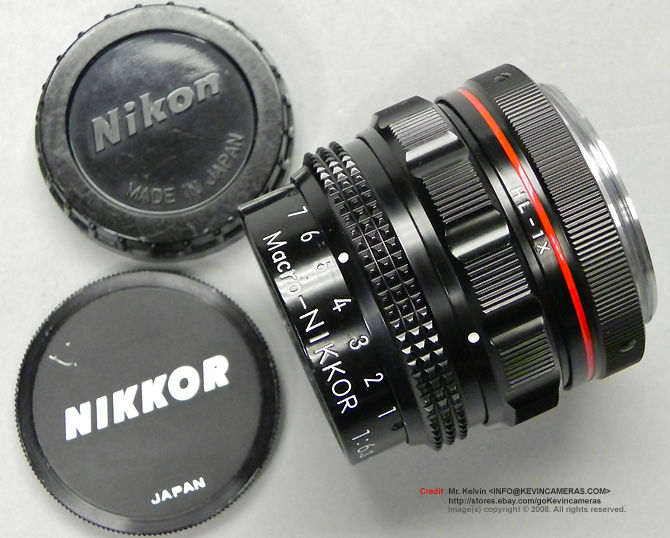 |
Among the 4 Macro Nikkor, this lens at
120mm has the longest focal length as well as the smallest maximum aperture. Similarly
as focal length increases, it provides a modest range of magnification from 1.2X~4X.
However, telephotographic focal length does rendering a more natural perspective.
On the other hand, as compare to other pin-size Macro-NIKKOR counterparts, the larger
dimension makes it looks closer like a normal 35mm lens optic.
|
 |
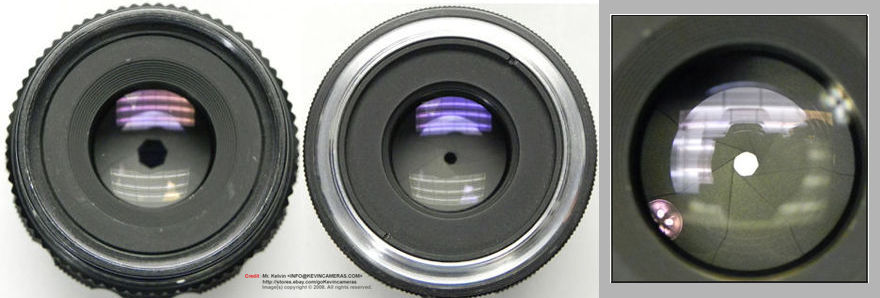 |
You may ask, can any of the two pin-sized
Macro-Nikkor 19/2.8, 35mm f/4.5 and the mid-sized
Macro-Nikkor 65mm/4.5 and this 120mm f/6.3 be used on a conventional Nikon reflex
SLR camera ? Yeap, possible but as the mount are different, it can be first, by coupled
them to a Nikon Bellow Device via an adapter such as BR-15, BR-16. Extension ring
may still be possible, but Bellow Unit, although more bulky and limits mobility,
but provides flexible movement in extension as well as control once it is being setup.
1) Here is a view by M. Akiyama of his setup comprised of a Macro-NIKKOR 1:6.3 f=120mm mounted on his Nikon F w/Bellow Unit.
2) Another view presented in his site shown a Macro-NIKKOR 35mm f/4.5 on a Nikon
Bellow Unit via BR-4 Adapter Ring (? refer below..).
Note: A Macro Adapter Ring is used to mount a
lens in the reverse position on a bellows attachment, it can be on either camera
body or with an extension ring. Step-down rings may require to fit individual lens
in order to be used on a Bellow Unit. the BR-15 adapter ring works for 39mm screw-mount
lenses to a Nikon F-mount body; while BR-16 ring enables any RMS-threaded microscope
objectives or enlarging lenses coupled to the BR-15 ring. Pictures of a Nikon BR-15 taken by Mr. destoutz / A Japanese site showing very well
taken shots of front / rear views of both the BR-15 with BR-16 as well as size comparison ( Individual ENLARGED views of: -BR-16 / BR-15 / Dual - Front / Rear Credit Link: alpsdo.cocolog-nifty.com).
Suggestive Link(s):
M. Akiyama's Redbook Nikkor information on Macro-NIKKOR lenses (with sub-links to other
good sources which may relate)
A weblink to Tomasz Dziubinski's portfolio taken with his Macro-NIKKOR 1:5.6 f=65mm |
| |
previous | NEXT | 2/7 backround, development history
and brief information on Ultra-Micro-NIKKOR series by Nippon Kogaku K.K. & @
28mm focal length models
Index Page:
Nippon
Kogaku K.K. S-Mount rangefinder version Micro-NIKKOR.C 1:3.5 f=5cm (50mm f/3.5)
Page 1:- Micro-NIKKOR 70mm f/5
/ Micro-NIKKOR 150mm/5.6 / Macro-NIKKOR Series
:- 19/2.8, 35mm f/4.5, 65mm/4.5, 120mm f/6.3
Page 2:- Ultra-Micro-NIKKOR
Series -28mm focal length models
Page 3:- Ultra-Micro-NIKKOR
Series - 29.5/30mm, 50 & 55mm focal length models
Page 4:- Ultra-Micro-NIKKOR
Series - 105, 125, 135mm & 150mm focal length models
Page 5:- Ultra-Micro-NIKKOR
Series - 155, 165, 225, 250 & 300mm focal length models
Page 6:- General information on other special purpose NIKKOR lenses for industrial.
technical and science applications
Nikon RF-Nikkor lenses:- Main Index Page
W-Nikkor-O 1:4 f=2.1cm | W-Nikkor.C 1:4 f=2.5cm | W-Nikkor.C
1:3.5 f= 2.8cm | W-Nikkor.C 3.5cm lens Group (3.5/2.5/1.8) | Stereo-Nikkor 1:3.5 f=3.5cm | 5cm (50mm) lens group | RF Micro-Nikkor 1:3.5 f=5cm (in progress) | Nikkor-P.C 1:2 f=8.5cm lens group / Nikkor-S.C 1:1.5 f=8.5cm lens group | Nikkor-P.C 1:2.5 f=10.5cm
lens group / Nikkor-T 1:4 f=10.5cm | Nikkor-Q.C 13.5cm lens group: 135/4, 135/3.5 Early
/ Last Version, 135/4 Bellow lens
| Nikkor-H 1:2.5
f=18cm | Nikkor-Q 1:4 f=25cm
| Nikkor-T 1:4.5 f=35cm | Nikkor-T.C 1:5 f=50cm | Reflex-Nikkor 100cm f/6.3
System Accessories
for Nikon Rangefinder cameras
Optical Finders (4 parts):- Fixed Focal length Finders (index page): 2.1cm,
2.5cm, 2.8cm,
3.5cm, 35cm Stereo,
5cm, 8.5cm, 10.5cm,
13.5cm | Variframe / Varifocal / Sport-frames
| Nikon Reflex Housing
Nikon
S36/S72/S250 Motor Drives
/ S36 Manual |
light meters | Nikon RF Flash/Speedlights | Close-up
photography / Repro Copy Outfit / Nikon Bellow Focusing Device (in progress) | Cases/Compartments | Lens & body caps,
Lens Hoods/shades,
Original Price Lists |
packaging/boxes
Instruction
Manuals
RELATIVE:- Nikon Rangefinder (RF) Models | Pictorial History of Nikon
A small visual library on
Nikon Ultra-Micro-Nikkor lenses
Manual Focus Nikkor lenses | Autofocus
Nikkor lenses
Related info:- Leica/Leitz
| Contax/Carl
Zeiss | Seiki Kogaku
(Canon)
| Message Board | lenses | Message Board | RF cameras
Nikon
Auto
Focus
Nikkor lenses:- Main Index Page
Nikon Manual
Focus
Nikkor lenses:- Main Index Page
| Back | Main
Index Page of Pictorial History of Nikon SLRs
about this photographic web site
 |
Home - Photography in Malaysia
|

Credit:- Special thanks to all the contributors of images
and content which made up the basis of the site. Note:certain content and
images appeared in this site were either scanned from official marketing leaflets,
brochures, sales manuals or publications published by Nikon over the years and/or
contribution from surfers who claimed originality of their work for educational purposes.
The creator of the site will not be responsible for may discrepancies arise from
such dispute except rectifying them after verification."Nikon",
"Nikkormat", "Nippon Kokagu KK" & "Nikkor"
are registered trade name of Nikon Corporation Inc., Japan. Site made with an Apple
G5 IMac.
|